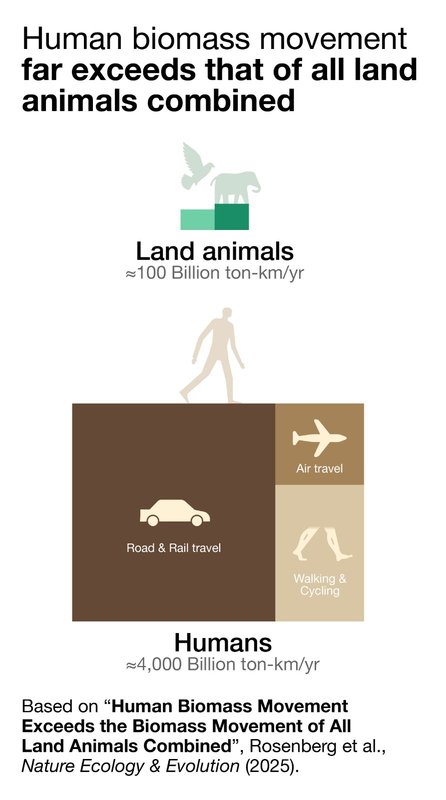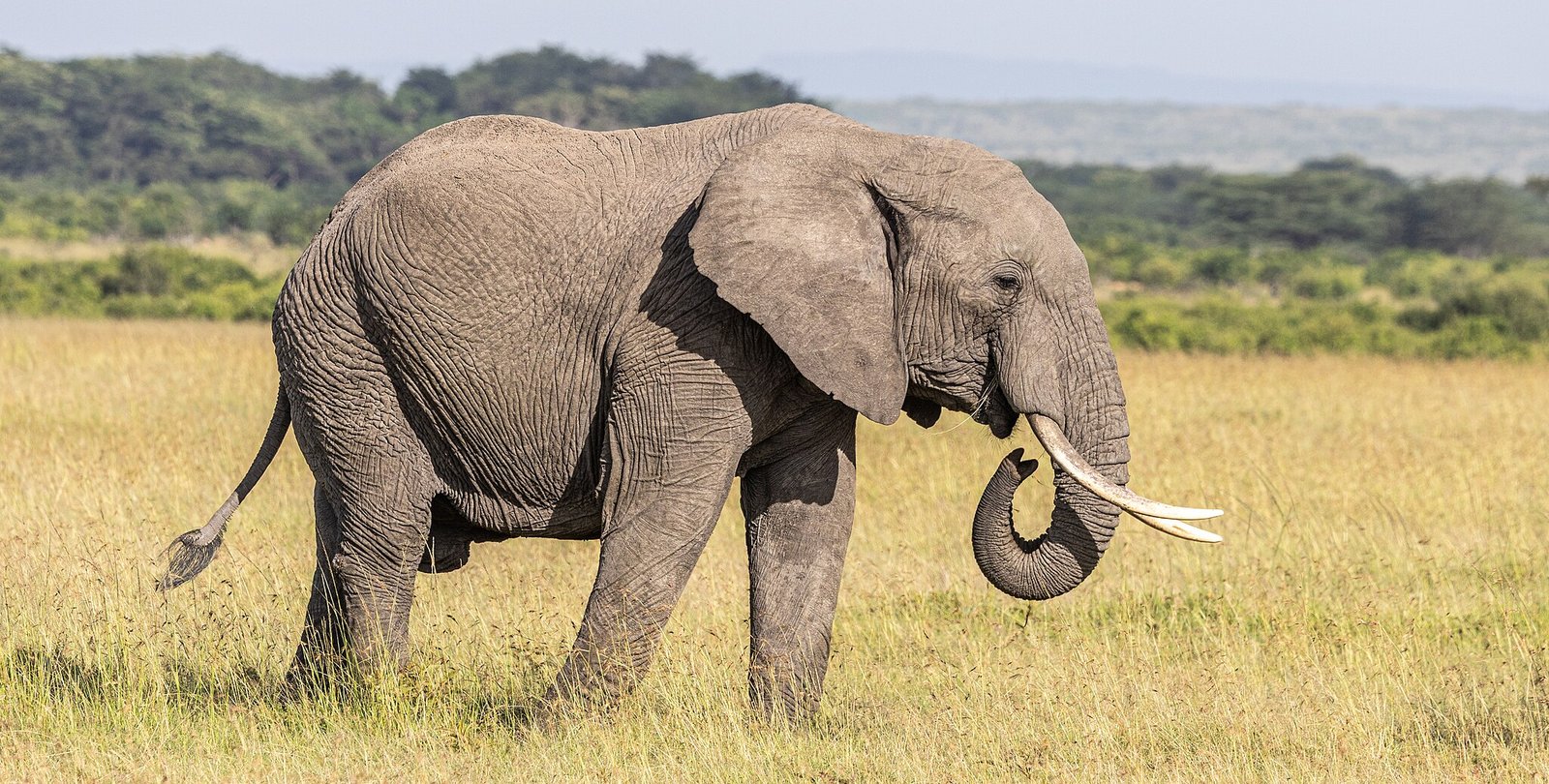Two new studies quantify key features of human and animal presence on Earth. The first study finds that the movement of human biomass today is 40 times greater than that of all wild land mammals, birds, and arthropods combined. Another study reveals that the combined biomass of wild land and marine mammals has plummeted by about 70 percent since 1850, whereas the biomass of humans has soared by roughly 700 percent and that of domesticated animals by 400 percent; those two categories have a combined biomass approaching about 1.1 billion tons.
The studies are collaborations between the Caltech laboratory of Rob Phillips, the Fred and Nancy Morris Professor of Biophysics, Biology, and Physics, and Ron Milo, professor of systems biology at the Weizmann Institute of Science in Israel.
"Centuries of work by naturalists have made it abundantly clear that living organisms are connected in giant webs of interactions," says Phillips. "But this is not just a vague idea; it is instead an idea that can be rendered quantitatively. These two papers make huge steps toward turning those intuitive ideas into concrete and quantitative time series."
Life in Motion: Movements of Humans and Wild Animals
Wolves roaming the Mongolian steppes cover more than 7,000 kilometers a year; the Arctic tern, meanwhile, flies from pole to pole in its annual migration. Compared to such long-distance travelers across land, sea, and sky, humans might seem like the ultimate couch potatoes. But a new study shows otherwise. In a paper appearing in Nature Ecology & Evolution on October 27, the team, led by Weizmann Institute postdoctoral scholar Yuval Rosenberg, presents a new ecological index—the biomass movement metric—which reveals that the movement of human biomass today is 40 times greater than that of all wild land mammals, wild birds, and arthropods combined. Since the Industrial Revolution some 170 years ago, human movement has skyrocketed, while animal movement in nature has dwindled to levels that could endanger ecosystems.
"It may be hard to grasp just how much humankind affects nature, but the biomass movement metric does provide a quantitative measure that reveals the true balance of power on Earth," Phillips says.
Life, by its very nature, is always in motion, and this constant activity shapes both the natural world and human society. Yet until now, no comparison has been made of the magnitude of overall movement by different species. Birds, for example, cross vast distances, but their overall body mass is tiny. By contrast, deep-sea fish may travel only short distances, but their combined biomass is enormous—about a thousand times greater than that of all birds.
The new biomass movement metric is calculated by multiplying the total biomass of a species—that is, the combined mass of all its members—by the total distance that species travels in a year. Calculating this metric globally made it possible for the researchers to quantify, for the first time, global movement across animal species and then compare it to that of humankind. The team combined data from hundreds of studies, historical and present, to make these calculations.
Together with collaborators Dominik Wiedenhofer and Doris Virág from BOKU university in Vienna, the researchers categorized human movement by mode of transportation. They found that about 65 percent of human biomass movement is by car or motorbike, 10 percent by airplane, 5 percent by train, and 20 percent by foot or on a bicycle. Remarkably, the biomass movement of humans simply walking is six times greater than that of all wild land mammals, birds, and arthropods combined. On average, each person travels about 30 kilometers a day by various means—slightly more than wild birds. By comparison, wild land mammals (excluding bats) travel only about 4 kilometers a day. In the air, human biomass movement by airplane is 10 times greater than that of all flying wildlife. In fact, the team found that a single airline burns as much energy as all wild birds combined.
"We often marvel at the power of nature compared to how small we are," Milo says. "But in practice, even the great migrations we see in Africa in nature documentaries—some of the largest land migrations on Earth—barely compare to the human biomass movement associated with people gathering from around the world for a single World Cup tournament."
Over 98 percent of current wild biomass movement occurs in the oceans, but even those vast habitats are severely affected by human activity.
"Since the Industrial Revolution, human biomass movement has soared by 4,000 percent, while that of marine animals has dropped by about 60 percent," says Rosenberg. "Decades of unregulated industrial whaling and overfishing have drastically altered marine ecosystems. Today we know that animal movement is critical for ecosystems to function properly and that ecosystems must remain connected to one another to survive. The global decline in animal movement is a warning sign to us all."
Wild mammals plummeting as livestock boom
In a related paper appearing in the journal Nature Communications on October 27, led by Weizmann graduate student Lior Greenspoon, the researchers calculated, for the first time, the total biomass of all mammalian species that have lived on Earth since 1850. They found that over this period, the combined biomass of wild land and marine mammals has plummeted by about 70 percent, from about 200 million tons to just 60 million tons. In contrast, the biomass of humans has soared by roughly 700 percent, and that of domesticated animals by 400 percent; together, those two groups now have a combined biomass of about 1.1 billion tons.
"It is important to establish quantitative historical baselines of wild animal populations so that we can avoid the shifting baseline syndrome—a gradual change in the accepted norms for the condition of the natural environment," says Greenspoon. "This study helps establish such a global baseline."
In particular, the team found a significant collapse in the biomass of marine mammals, like whales, due to industrial fishing and hunting. Marine mammals now have only 30 percent the total biomass as they did in 1850.
"To get a sense of the consequences of these changes in the mass distributions of mammals over time, I find it both fun and interesting to compare the total fertilizer used across the entire planet to the amount of missing whale poop per year due to the missing 3 million whales killed during the 20th century," says Phillips. "Perhaps people will be surprised to find that those two numbers are comparable."
The Nature Ecology & Evolution paper is titled "Human biomass movement exceeds the biomass movement of all land animals combined." In addition to Rosenberg, Milo, and Phillips, co-authors are Dominik Wiedenhofer and Doris Virág of BOKU University in Vienna, Austria; Gabriel Bar-Sella, Lior Greenspoon, and Barr Herrnstadt from the Weizmann Institute of Science in Israel; and Lewis Akenji from the Hot or Cool Institute in Berlin, Germany. Funding was provided by the Schwartz-Reisman Collaborative Science Program, the Mary and Tom Beck-Canadian Center for Alternative Energy Research, the Weizmann Institute of Science, and the European Research Council.
The Nature Communications paper is titled "The Global Biomass of Mammals Since 1850." In addition to Greenspoon, Milo, and Phillips, co-authors are Noam Ramot, Uri Moran, and Elad Noor of the Weizmann Institute of Science in Israel; and Uri Roll of Ben-Gurion University of the Negev in Israel.
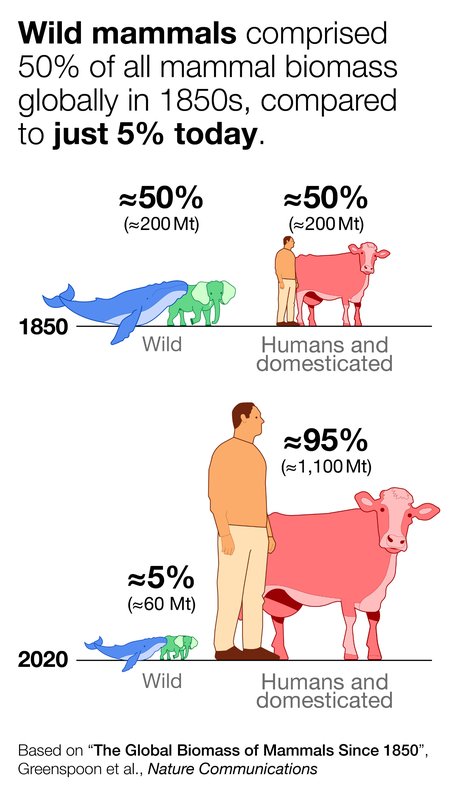 The global biomass of humans and domesticated animals has soared since 1850.
Credit: Courtesy of R. Milo
The global biomass of humans and domesticated animals has soared since 1850.
Credit: Courtesy of R. Milo
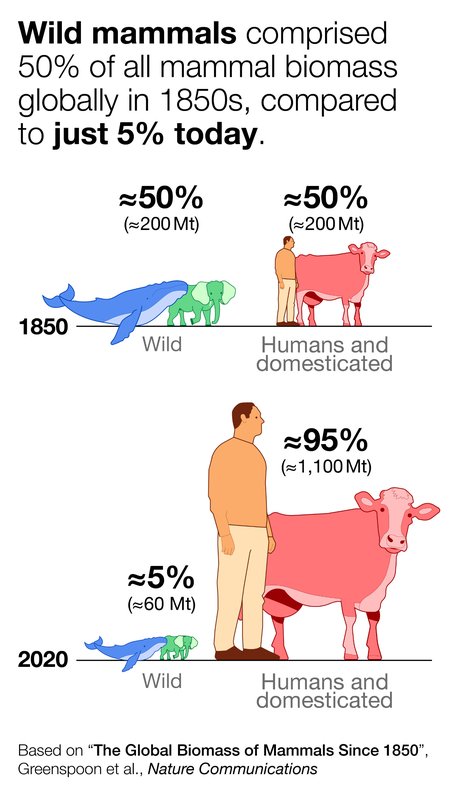
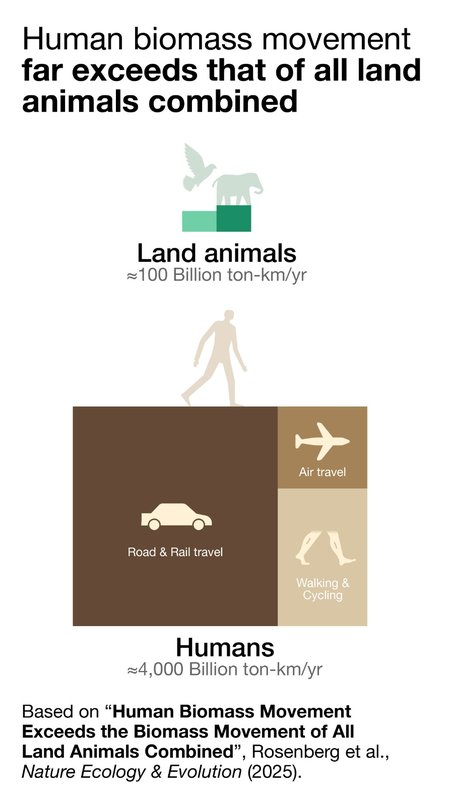 The movement and migration of land animals is around 10 times less than the movement of humans alone, which includes walking, cycling, and road, rail, and air travel.
Credit: Courtesy of R. Milo
The movement and migration of land animals is around 10 times less than the movement of humans alone, which includes walking, cycling, and road, rail, and air travel.
Credit: Courtesy of R. Milo
